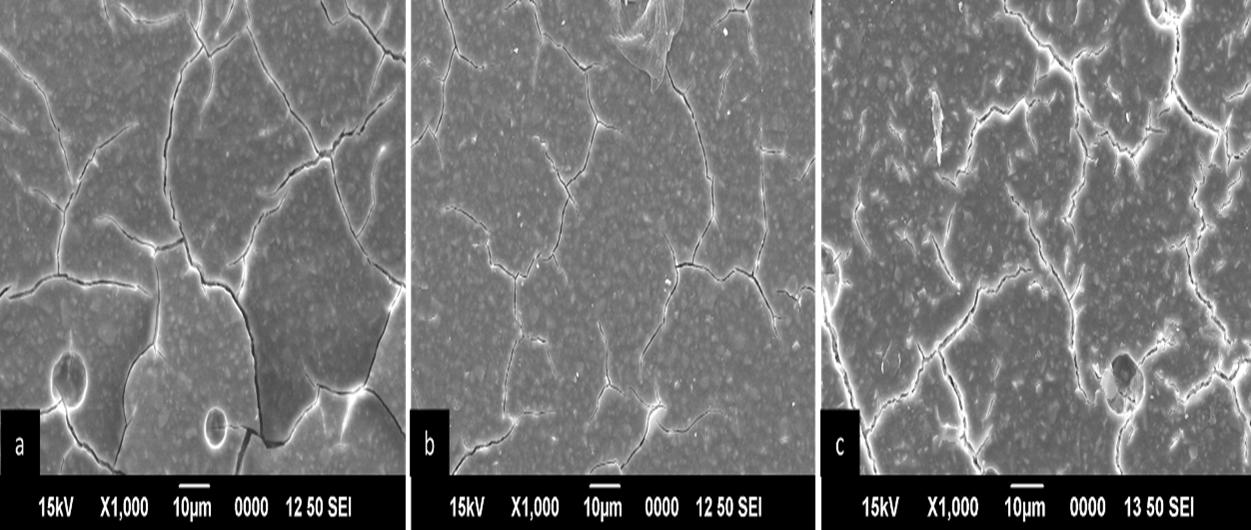
Evaluation of the Effect of Acidic Beverages on the Surface Roughness of Glass Ionomer Cement- An In-Vitro Study
Abstract
Context: Glass Ionomer Cement (GIC) plays a very major role in paediatric dentistry due to its fluoride releasing properties and cost effectiveness. Factors that cause surface changes on enamel can similarly influence certain properties of the restoration. This clinically jeopardizes the life of the restoration, as the ultimate success of the restorative material is indicated by its longevity in the oral cavity. One such vulnerability is the surface erosion of restorative cement by acidic beverages.
Aims: To evaluate the effect of 4 commonly consumed beverages on the surface integrity of Glass ionomer cement.
Settings and Design: GIC pellets of three brands were made and exposed to acidic beverages for two intervals of 5 mins and 25 mins.
Material and Methods: Control samples were evaluated using surface profilometry to get base values and Scanning Electron Microscope (SEM) imaging as an adjuvant. Test samples were also subject to profilometry and SEM imaging after exposure to acidic beverages.
Statistical analysis used: One-way ANOVA was applied and SPSS version 22.0 was used to analyse the data. Significance level was fixed as 5% (α = 0.05).
Results: Test samples showed increased surface roughness when compared to base samples with erosion directly proportional to exposure time. Non-coloured
carbonated beverage showed more erosive potential at short duration whereas natural fruit juice showed increased erosion at longer duration.
Conclusions: Post restorative protection along with diet control needs to be practised as an essential step to maintain the longevity of GIC.
Full Text:
PDFReferences
Maganur P, Satish V, Prabhakar A, Namineni S. Effect of Soft Drinks and Fresh Fruit Juice on Surface Roughness of Commonly used Restorative Materials. Int J Clin Pediatr Dent. 2015;8(1):1–5.
Francisconi LF, Scaffa PMC, de Barros VR dos SP, Coutinho M, Francisconi PAS. Glass ionomer cements and their role in the restoration of non-carious cervical lesions. J Appl Oral Sci. 2009 Oct;17(5):364–9.
Tran LA, Messer LB. Clinicians’ choices of restorative materials for children. Aust Dent J. 2003 Dec;48(4):221–32.
Cho SY, Cheng AC. A review of glass ionomer restorations in the primary dentition. J Can Dent Assoc. 1999 Oct;65(9):491–5.
Crisp S, Lewis BG, Wilson AD. Characterization of glass-ionomer cements. Journal of Dentistry. 1980 Jan 1;8(1):68–74.
S M, Y M, Y Y, M Y. Erosion process of a glass ionomer cement in organic acids. Dent Mater J. 1984 Dec 1;3(2):210–9.
Fukazawa M, Matsuya S, Yamane M. Mechanism for erosion of glass-ionomer cements in an acidic buffer solution. J Dent Res. 1987 Dec;66(12):1770–4.
Shabanian M, Richards LC. In vitro wear rates of materials under different loads and varying pH. J Prosthet Dent. 2002 Jun;87(6):650–6.
Hamouda IM. Effects of various beverages on hardness, roughness, and solubility of esthetic restorative materials. J Esthet Restor Dent. 2011 Oct;23(5):315–22.
C Maganur P, R Prabhakar A, Satish V, Namineni S, Kurthukoti A. Erosive Effect of Soft Drink and Fresh Fruit Juice on Restorative Materials. Patil S, editor. World Journal of Dentistry. 2013 Jan 15;4:32–40.
Grobler SR, Senekal PJ, Laubscher JA. In vitro demineralization of enamel by orange juice, apple juice, Pepsi Cola and Diet Pepsi Cola. Clin Prev Dent. 1990 Dec;12(5):5–9.
Grando LJ, Tames DR, Cardoso AC, Gabilan NH. In vitro study of enamel erosion caused by soft drinks and lemon juice in deciduous teeth analysed by stereomicroscopy and scanning electron microscopy. Caries Res. 1996;30(5):373–8.
Reddy DSR, Kumar RA, Venkatesan SM, Narayan GS, Duraivel D, Indra R. Influence of citric acid on the surface texture of glass ionomer restorative materials. J Conserv Dent. 2014;17(5):436–9.
Abu-Bakr N, Han L, Okamoto A, Iwaku M. Changes in the mechanical properties and surface texture of compomer immersed in various media. J Prosthet Dent. 2000 Oct;84(4):444–52.
Torres CP, Chinelatti MA, Gomes-Silva JM, Rizóli FA, Oliveira MAH de M, Palma-Dibb RG, et al. Surface and subsurface erosion of primary enamel by acid beverages over time. Brazilian Dental Journal. 2010;21(4):337–45.
Yap AU, Low JS, Ong LF. Effect of food-simulating liquids on surface characteristics of composite and polyacid-modified composite restoratives. Oper Dent. 2000 Jun;25(3):170–6.
Shaw L, Smith AJ. Dental erosion--the problem and some practical solutions. Br Dent J. 1999 Feb 13;186(3):115–8.
Mohamed-Tahir MA, Yap AUJ. Effects of pH on the surface texture of glass ionomer based/containing restorative materials. Oper Dent. 2004 Oct;29(5):586–91.
Fukazawa M, Matsuya S, Yamane M. The mechanism for erosion of glass-ionomer cements in organic-acid buffer solutions. J Dent Res. 1990 May;69(5):1175–9.
Künzel W, Cruz MS, Fischer T. Dental erosion in Cuban children associated with excessive consumption of oranges. Eur J Oral Sci. 2000 Apr;108(2):104–9.
Bajwa N, Pathak A. Change in Surface Roughness of Esthetic Restorative Materials after Exposure to Different Immersion Regimes in a Cola Drink. ISRN dentistry. 2014 Mar 23;2014:353926.
Bang S-Y, Kim E-J, Kim H-J, Nam S-H, Kim Y-J. The effect of acidic drinks on the surface of tooth-colored restorative materials. Journal of The Korean Academy of Pediatric Dentistry. 2006 Aug 31;33(3):469–81.
Hengtrakool C, Kukiattrakoon B, Kedjarune-Leggat U. Effect of Naturally Acidic Agents on Microhardness and Surface Micromorphology of Restorative Materials. Eur J Dent. 2011 Jan;5(1):89–100.
Refbacks
- There are currently no refbacks.

This work is licensed under a Creative Commons Attribution-NoDerivatives 4.0 International License.
An Initiative of The Tamil Nadu Dr MGR Medical University
 University Journal of Surgery and Surgical Specialities
University Journal of Surgery and Surgical Specialities